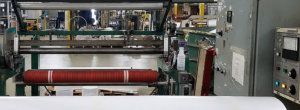Fabric to Foam Laminating: Your Introduction to the Process

At CTI, we like to talk about the key manufacturing capabilities we offer so that our clients can understand them. Today, we’ll discuss fabric to foam laminating, one option in our huge array of laminating processes.
What is Lamination?
Lamination, in its simplest definition, means taking a base layer of flat material and attaching another flat layer to it. To accomplish this, lamination uses tools like heat, pressure, and/or adhesives to bond the layers.
The base layer is known as the substrate. Usually, it is some type of web goods. In the case of fabric to foam laminating, the substrate is a piece of polyurethane foam. The second web is the material that will be bonded to the substrate. In this case, the material is any kind of fabric or textile.
The Lamination Process
Fabric to foam laminating typically happens on a laminating machine that uses a roll laminating process. That means that both webs come in rolls that are gradually unspooled by machines and bonded together.
A laminator machine uses motorized rollers to move the substrate through the machine. In the process, the rollers apply pressure, heat, and/or adhesive to the web material. This allows the material being laminated to form a strong bond with the outer layer.
It’s important not to confuse laminating with adhesive coating, although the two processes have similarities and are often used together. Coating is simply applying a liquid to a surface, while laminating specifically requires two types of web goods. When your process uses liquid adhesive, however, coating is a necessary part of laminating.
Common Methods of Fabric to Foam Laminating
What are the techniques that conversion manufacturers like CTI use for laminating foam? These are the two most common:
- Flame Lamination: A laminating technique that involves heating the surface of the foam with an open flame to produce a tacky texture. The heat and texture allow the two surfaces to bond without the need for additional adhesives.
- Adhesive Lamination: Another laminating technique that involves coating one of the webs with an adhesive compound. Rollers then press the laminated web onto the other web. This forms a durable adhesive bond.
A fabric to foam laminating process can use either one of these techniques to great effect.
Use Cases for Laminated Foam
Where do we see laminated foam products used in the real world? CTI has completed fabric to foam laminating projects for clients with a huge range of applications, including:
- Automotive interior liners
- Bedding, chairs, and other furniture
- Household cleaning products
- Acoustic foam panels
- Carpets
- Personal care products
However, don’t worry if your particular application isn’t listed here. CTI is always happy to take on new challenges for our clients. In fact, we regularly design custom lamination solutions from scratch, with a long track record of success.
Consider Toll Processing
CTI also offers toll processing which can save you time and money. Here is a detailed look at 10 reasons companies choose to outsource some of their production needs.
1. Fast Processing
Toll processing companies offer large facilities, state-of-the-art equipment, and expert staff. This, of course, helps expedite production times for the hiring company. When you choose to have an outside company known for their lamination expertise take control of your product lamination, you speed up your production.
2. High-Quality Materials
Companies that specialize in certain manufacturing services are bona fide experts in that process. So, you can count on receiving consistently high quality from an established toll processor. Since your company provides the raw material (unlike in a contract manufacturing partnership), you can be certain that only the high-quality materials you select are used in processing.
3. Expedited Customer Delivery
When you speed up production times, you also expedite the final product delivery of finished goods to your customers. Consequently, when time is of the essence, and your customers need their product, outsourcing to a toll processing company is an advantage.
4. Cost Savings on Equipment
You won’t need to buy expensive equipment if you partner with a toll processor. We have the manufacturing equipment necessary to fulfill the needs of clients in industries such as:
- Aeronautic
- Automotive
- Consumer Products
- Fiberglass
- Insurance
- Medical
- Office Furniture
- Packaging
- Rolled Goods
- Textiles
- Vinyl and Paper Laminates
5. Company Savings Passed on to Customer
Because of the significant savings, you can realize by partnering with a toll manufacturer, you can pass those savings on to your customer. Consequently, this can help give you a competitive advantage in the market.
6. Production Flexibility
Hiring an outside company for processing gives you enormous flexibility. This is because you can decide to switch from in-house to a company offering toll processing service at any time during the production cycle.
7. Customized Formatting and Packaging
When it comes to customization, you can’t go wrong with a toll manufacturing company like CTI. CTI is respected for providing endless possibilities when it comes to formatting and packaging.
8. Manufacturing Expertise
Toll manufacturers must be manufacturing experts or else they won’t last long. CTI, for example, has been the gold standard since 1993. We proudly adhere to all industry standards, such as ASME and ASTM.
9. Streamlined Logistics
As your toll manufacturing partner, CTI streamlines logistics for you. We can assist with offsite warehouses, storage, delivery, and more.
10. Reduced Capital Investment
We are in our fourth decade of business. This means that we have acquired, upgraded, and heavily invested in all the latest equipment innovations over the years. We’ve also trained our team, extensively, and boast a huge facility. All of this means that you don’t have to splurge on space, equipment, training, etc. We help you keep your capital investment down, as your toll processing company.
Laminating Services from CTI
Whether you choose toll processing or contract manufacturing, we offer a full range of lamination services for roll and sheet goods. Fabric to foam lamination is just one of our many capabilities. In fact, we offer nearly any laminating process you need!
Since we’re a contract manufacturer, you’ll also have access to these services on demand, when you need them. Plus, we make it simple to integrate almost any laminating technique into your manufacturing process. We’ve designed our modular system to offer ultimate flexibility in everything from design prototyping to production runs.
Our team is ready to get to work on your custom fabric to foam laminating needs. Call us at 419-924-5566 or contact us online, and we’ll help you get started with a free quote.
- << < Previous Post
- 1
- 2
- ...
- 111
- ...
- 250
- 251 Next Post > >>

